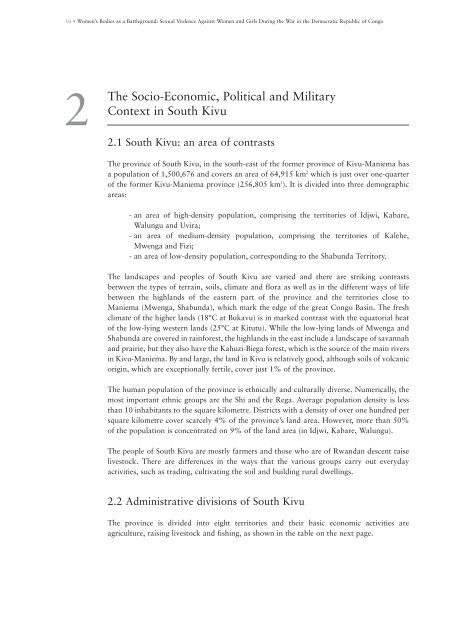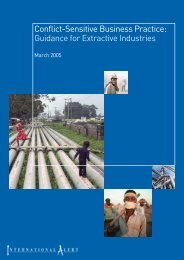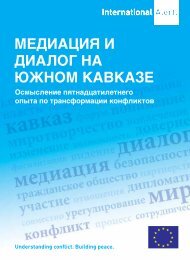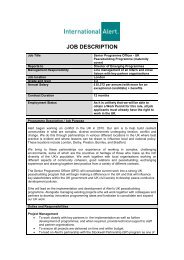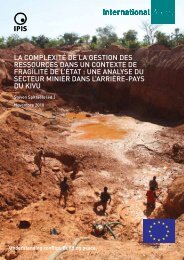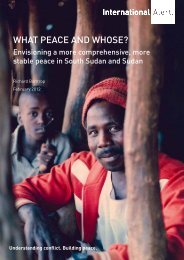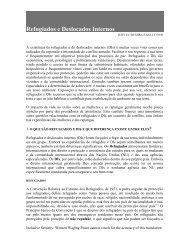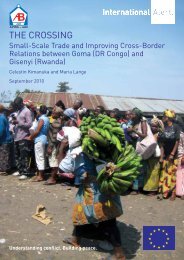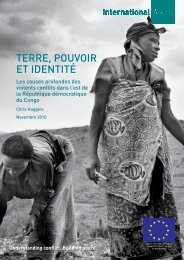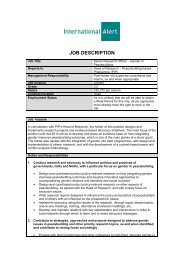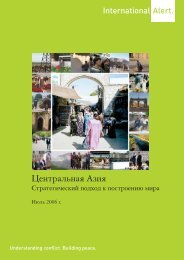16 • Women’s Bodies as a Battleground: Sexual Violence Against Women and Girls During the War in the Democratic Republic of Congo2The Socio-Economic, Political and MilitaryContext in South Kivu2.1 South Kivu: an area of contrastsThe province of South Kivu, in the south-east of the former province of Kivu-Maniema hasa population of 1,500,676 and covers an area of 64,915 km 2 which is just over one-quarterof the former Kivu-Maniema province (256,805 km 2 ). It is divided into three demographicareas:- an area of high-density population, comprising the territories of Idjwi, Kabare,Walungu and Uvira;- an area of medium-density population, comprising the territories of Kalehe,Mwenga and Fizi;- an area of low-density population, corresponding to the Shabunda Territory.The landscapes and peoples of South Kivu are varied and there are striking contrastsbetween the types of terrain, soils, climate and flora as well as in the different ways of lifebetween the highlands of the eastern part of the province and the territories close toManiema (Mwenga, Shabunda), which mark the edge of the great Congo Basin. The freshclimate of the higher lands (18°C at Bukavu) is in marked contrast with the equatorial heatof the low-lying western lands (25°C at Kitutu). While the low-lying lands of Mwenga andShabunda are covered in rainforest, the highlands in the east include a landscape of savannahand prairie, but they also have the Kahuzi-Biega forest, which is the source of the main riversin Kivu-Maniema. By and large, the land in Kivu is relatively good, although soils of volcanicorigin, which are exceptionally fertile, cover just 1% of the province.The human population of the province is ethnically and culturally diverse. Numerically, themost important ethnic groups are the Shi and the Rega. Average population density is lessthan 10 inhabitants to the square kilometre. Districts with a density of over one hundred persquare kilometre cover scarcely 4% of the province’s land area. However, more than 50%of the population is concentrated on 9% of the land area (in Idjwi, Kabare, Walungu).The people of South Kivu are mostly farmers and those who are of Rwandan descent raiselivestock. There are differences in the ways that the various groups carry out everydayactivities, such as trading, cultivating the soil and building rural dwellings.2.2 Administrative divisions of South KivuThe province is divided into eight territories and their basic economic activities areagriculture, raising livestock and fishing, as shown in the table on the next page.
17 • Women’s Bodies as a Battleground: Sexual Violence Against Women and Girls During the War in the Democratic Republic of CongoTERRITORY LOCAL COMMUNITY AREA (sq.km) BASIC ECONOMIC ACTIVITIES1. FIZI 1. Lulenge 3248 km 2 Raising livestock2. Mutambala 1216 km 2 Fishing3. Ngandja 5074 km 2 Fishing4. Tanganika 1866 km 2 Fishing2. IDJWI 1. Ntambuka 126 km 2 Agriculture/fishing2. Rubenga 153 km 2 Agriculture/fishing3. KABARE 1. Kabare 554 km 2 Agriculture/raising livestock2. Nindja 923 km 2 Agriculture/raising livestock4. KALEHE 1. Buhavu 2892 km 2 Agriculture/raising livestock2. Buloho 1180 km 2 Agriculture/raising livestock5. MWENGA 1. Basile 2856 km 2 Agriculture2. Burhinyi 325 km 2 Agriculture/raising livestock3. Itombwe 3574 km 2 Agriculture/raising livestock4. Luindi 1180 km 2 Agriculture5. Luhwindja 195 km 2 Agriculture/raising livestock6. Wamuzimu 4176 km 2 Agriculture6. SHABUNDA 1. Bakisi 18,508 km 2 Agriculture/logging2. Wakabongo 6701 km 2 Agriculture/raising livestock7. UVIRA 1. Bafulero 1421 km 2 Agriculture/raising livestock2. Bavira 1335 km 2 Agriculture/raising livestock3. Plaine Ruzizi 644 km 2 Agriculture/raising livestock8. WALUNGU 1. Ngweshe 1599 km 2 Agriculture/raising livestock2. Kaziba 376 km 2 Agriculture/raising livestockTable 1 : Administrative divisions and basic economic activities of South Kivu2.3 The socio-economic consequences of the war in South KivuThe war, together with its inevitable corollary, systematic pillaging by the fighting forces, has destroyedSouth Kivu’s economy and social infrastructure, which had already been badly affected by years ofneglect and poor management under Mobutu’s clientelist regime. The conflict has significantlyimpoverished the local people. In 2002, a manual worker earned about $2 a day. 9The war has left no sector of the economy unscathed. In the primary sector, villages no longerproduce enough food for self-sufficiency, so there is a chronic food shortage in the region. Accordingto the UN Food and Agriculture Organization (FAO), 10 10–30% of the population of South Kivusuffer from severe malnutrition. This situation is caused by two factors. Firstly, the soil is exhaustedthrough over-exploitation and, in some areas of high population density, especially the mountainousareas of South Kivu, it has to sustain too many people. Secondly, this food shortage has beenexacerbated by strain on local communities caused by the huge influx of Rwandan refugees followingthe 1994 genocide and the unprecedented displacement of people fleeing the endless fighting betweenthe various political factions. It is estimated that 60% of the population of South Kivu has beendisplaced since war broke out in 1996. 11Moreover, livestock farming and fishing activities decreased significantly during the war because animalsand equipment were plundered. Most of the region’s cattle, which are particularly important on the HautPlateaux of Itombwe and the Ruzizi plain, were stolen. Industrial poultry farming was entirely destroyedduring the disturbances of October–November 1996. 129.Médecins Sans Frontières (Holland), The humanitarian situation in the Territories of Uvira, Nundu and Fizi, South Kivu,Democratic Republic of the Congo. An Assessment Report, Netherlands, September 2002, p.16.10.Failly, D. de, ‘L’économie du Sud- Kivu 1990-2000 : Mutations profondes cachées par une panne’ in L’Afrique des Grands Lacs,Annuaire 1999-2000, eds. Marysse, S., and Reyntjens, F., Centre d’Etudes de la Région des Grands Lacs, L’Harmattan, Paris,2000, pp. 161-188.11.Médecins Sans Frontières (Holland), op.cit.12.Failly, D. de, op.cit.


